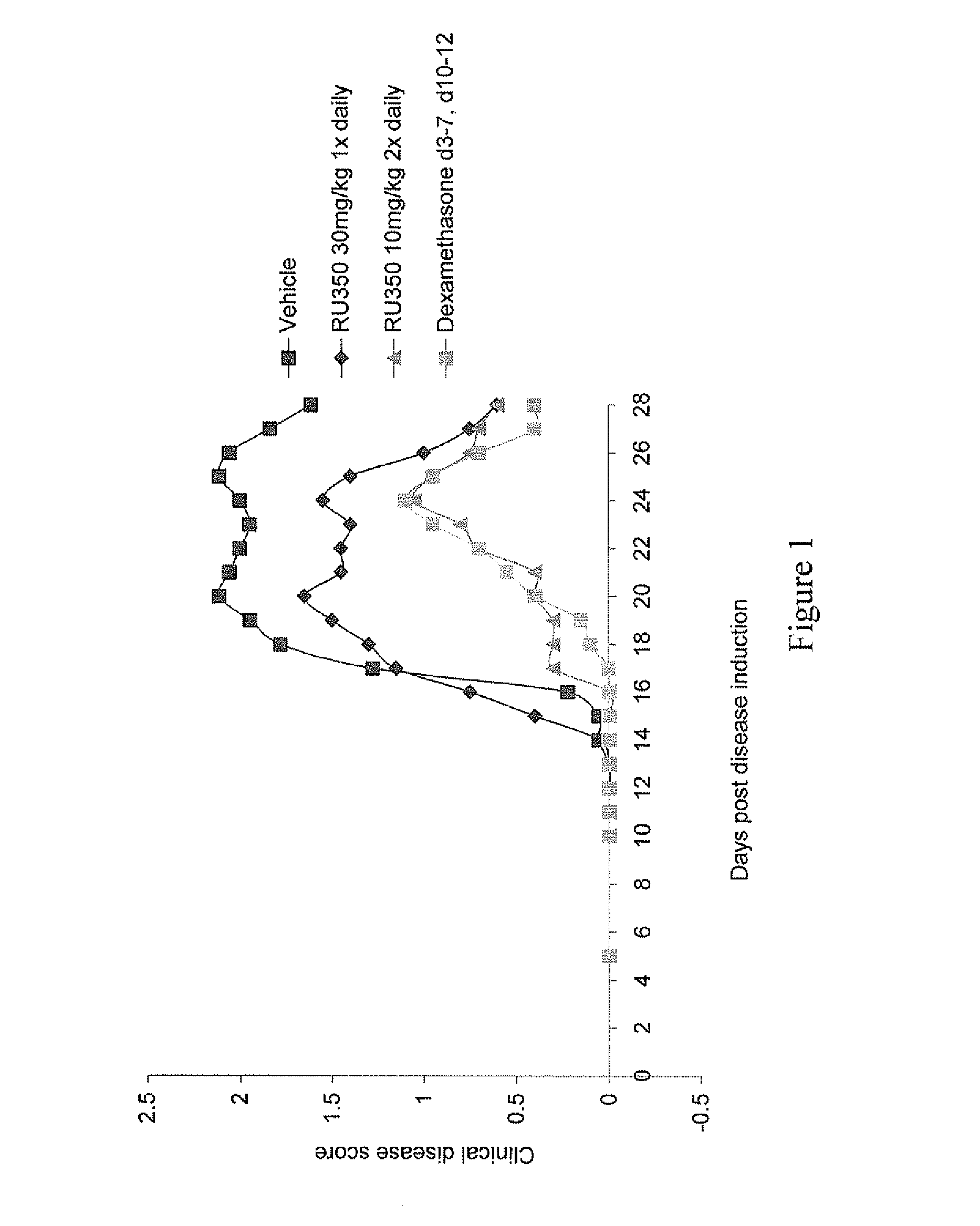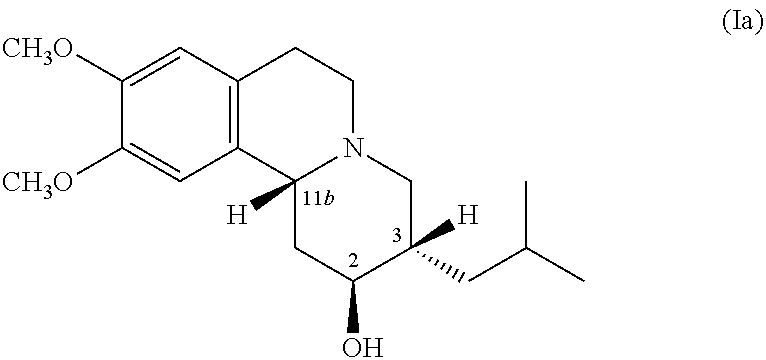Use of 3, 11b-cis-dihydrotetrabenazine in the treatment of multiple sclerosis and autoimmune myelitis
a technology of tetrabenazine and cis-dihydrotetrabenazine, which is applied in the direction of immunodeficiency, drug composition, biocide, etc., can solve the problems of chromatographic separation, changes in sensation, and the inability of nerve fibres to effectively conduct electrical signals, so as to avoid chromatographic separation
- Summary
- Abstract
- Description
- Claims
- Application Information
AI Technical Summary
Benefits of technology
Problems solved by technology
Method used
Image
Examples
example 1
Preparation of 2S,3S,11bR and 2R,3R,11bS Isomers of Dihydrotetrabenazine
1A. Reduction of RR / SS Tetrabenazine
[0150]
[0151]1M L-Selectride in tetrahydrofuran (135 ml, 135 mmol, 2.87 eq.) was added slowly over 30 minutes to a stirred solution of tetrabenazine RR / SS racemate (15 g, 47 mmol) in ethanol (75 ml) and tetrahydrofuran (75 ml) at 0° C. After addition was complete the mixture was stirred at 0° C. for 30 minutes and then allowed to warm to room temperature.
[0152]The mixture was poured onto crushed ice (300 g) and water (100 ml) added. The solution was extracted with diethyl ether (2×200 ml) and the combined ethereal extracts washed with water (100 ml) and partly dried over anhydrous potassium carbonate. Drying was completed using anhydrous magnesium sulphate and, after filtration, the solvent was removed at reduced pressure (shielded from the light, bath temperature <20° C.) to afford a pale yellow solid.
[0153]The solid was slurried with petroleum ether (30-40° C.) and filtered t...
example 2
Alternative Method of Preparation of Isomer B and Preparation of Mesylate Salt 2A. Reduction of RR / SS Tetrabenazine
[0174]
[0175]1M L-Selectride in tetrahydrofuran (52 ml, 52 mmol, 1.1 eq) was added slowly over 30 minutes to a cooled (ice bath), stirred solution of tetrabenazine racemate (15 g, 47 mmol) in tetrahydrofuran (56 ml). After the addition was complete, the mixture was allowed to warm to room temperature and stirred for a further six hours. TLC analysis (silica, ethyl acetate) showed only very minor amounts of starting material remained.
[0176]The mixture was poured on to a stirred mixture of crushed ice (112 g), water (56 ml) and glacial acetic acid (12.2 g). The resulting yellow solution was washed with ether (2×50 ml) and basified by the slow addition of solid sodium carbonate (ca. 13 g). Pet-ether (30-40° C.) (56 ml) was added to the mixture with stirring and the crude β-DHTBZ was collected as a white solid by filtration.
[0177]The crude solid was dissolved in dichlorometh...
example 3
X-Ray Crystallographic Studies on Isomer B
[0191]The (S)-(+)-Camphor-10-sulphonic acid salt of Isomer B was prepared and a single crystal was subjected to X-ray crystallographic studies under the following conditions:
[0192]Diffractometer: Nonius KappaCCD area detector (t / i scans and OJ scans to fill asymmetric unit).
[0193]Cell determination: DirAx (Duisenberg, A. J. M. (1992). J. Appl. Cryst. 25, 92-96.)
[0194]Data collection: Collect (Collect: Data collection software, R. Hooft, Nonius B. V, 1998)
[0195]Data reduction and cell refinement: Demo (Z. Otwinowski & W. Minor, Methods in Enzymology (1997) Vol. 276: Macromolecular Crystallography, part A, pp. 307-326; C. W. Carter, Jr & R. M. Sweet, Eds., Academic Press).
[0196]Absorption correction: Sheldrick, G. M. SADABS—Bruker Nonius area detector scaling and absorption correction—V2.\0
[0197]Structure solution: SHELXS97 (G. M. Sheldrick, Acta Cryst. (1990) A46 467-473). Structure refinement: SHELXL97 (G. M. Sheldrick (1997), University of ...
PUM
| Property | Measurement | Unit |
|---|---|---|
| Fraction | aaaaa | aaaaa |
| Fraction | aaaaa | aaaaa |
| Mobility | aaaaa | aaaaa |
Abstract
Description
Claims
Application Information
 Login to View More
Login to View More - R&D
- Intellectual Property
- Life Sciences
- Materials
- Tech Scout
- Unparalleled Data Quality
- Higher Quality Content
- 60% Fewer Hallucinations
Browse by: Latest US Patents, China's latest patents, Technical Efficacy Thesaurus, Application Domain, Technology Topic, Popular Technical Reports.
© 2025 PatSnap. All rights reserved.Legal|Privacy policy|Modern Slavery Act Transparency Statement|Sitemap|About US| Contact US: help@patsnap.com



